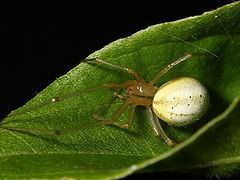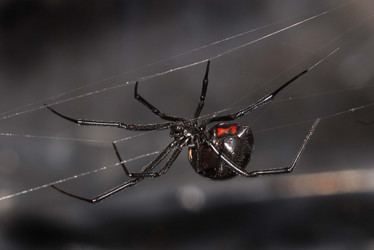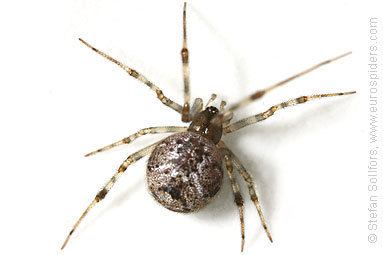Order Araneae Scientific name Theridiidae | Higher classification Araneoidea Rank Family | |
Lifespan Southern black widow: 1 – 3 years Length Southern black widow: 3.8 cm Lower classifications | ||
Nesticodes rufipes spider theridiidae red house spider
Theridiidae is a large family of spiders, also known as the tangle-web spiders, cobweb spiders and comb-footed spiders. The diverse family includes over 2200 species in over 100 genera of three-dimensional space-web-builders found throughout the world. Theridiid spiders are entelegyne (have a genital plate in the female) araneomorph ecribellate (use sticky capture silk instead of woolly silk) spiders that often build tangle space webs and have a comb of serrated bristles (setae) on the tarsus of the fourth leg.
Contents
- Nesticodes rufipes spider theridiidae red house spider
- Tangle web spider family theridiidae
- Webs
- Genera
- References

The family includes some model organisms for research, for example, the genus Latrodectus, the medically important widow spiders. In addition to studies characterizing their venom and its clinical manifestation, widow spiders are broadly used in research on spider silk, and on sexual biology including sexual cannibalism.

Anelosimus spiders are also model organisms, used for the study of sociality, its evolution, and its ecological and evolutionary causes and consequences. They are particularly important for such studies as the genus contains species varying from solitary to permanently social, and because sociality has evolved frequently within the genus allowing comparative studies across species. These spiders are also a promising model for the study of inbreeding as their mating system co-varies with sociality, and all permanently social species are highly inbred.

One species in Theridion, the Hawaiian T. grallator, is used as a model to understand the selective forces and the genetic basis of color polymorphism within species. Theridion grallator is known as the "happyface" spider, as certain morphs have a pattern uncannily resembling a smiley face or a grinning clown face on their yellow body.

The family also contains the well studied kleptoparasitic species of the subfamily Argyrodinae (including Argyrodes, Faiditus, and Neospintharus) which often have triangular bodies. These spiders live in the webs of larger spiders and pilfer small prey caught by their host's web, eat prey killed by the host spider, and may consume silk from the host web, as well as attack and eat the host itself.
The largest genus with over 600 species currently placed in it is Theridion, but it is not monophyletic. Another large genus is Parasteatoda, previously Achaearanea, which includes the North American common house spider.
Many theridiids trap ants and other ground dwelling insects by means of elastic sticky silk trap lines leading to the soil surface. Despite their name, cobweb or tangle-web spiders have a huge range of web architectures.
Tangle web spider family theridiidae
Webs
Theridiidae is probably the only family with a large diversity of spider web forms: there is a high within-taxon diversity (e.g. in Latrodectus), as well as convergence in different taxa. Theridiid gumfoot-webs consist of frame lines that anchor them to surroundings and of support threads, which possess viscid silk. Four main web types are currently recognized: among webs with gumfooted lines, there are webs with a central retreat (Achaearanea-type) and those with a peripheral retreat (Latrodectus-type). Among webs without gumfooted lines, there are those that contain viscid silk (Theridion-type) and those with a sheet-like structure, which do not contain visible viscid silk (Coleosoma-type). However, there are many undescribed web forms.
Building of gumfooted lines constitutes a unique stereotyped behaviour and is most probably homologous for Theridiidae and its sister family Nesticidae. Webs remain in place for extended periods and are expanded and repaired, but no regular pattern of web replacement has been observed.
Genera
As of November 2015, the World Spider Catalog accepts the following extant genera:
About 35 extinct genera have also been placed in the family.
